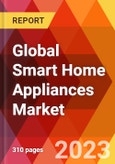The global smart home appliance market, valued at USD 59.69 billion in 2022, is projected to reach USD 143.97 billion by 2030, reflecting a CAGR of 10.71% during the forecast period. Smart home appliances are electrical devices used in homes, performing various domestic functions such as cooking, cleaning, and food preservation. These machines are equipped with decision-making capabilities to enhance convenience.The global smart home appliance market, valued at USD 59.69 billion in 2022, is projected to reach USD 143.97 billion by 2030, reflecting a CAGR of 10.71% during the forecast period
Growth Influencers:
The global internet and smartphone penetration rate stood at 68% in 2022, marking an increase since 2018. The world was home to approximately 6.3 billion smartphone subscriptions amidst a global population of around 7.4 billion. This growing internet and smartphone usage has propelled the launch of smart appliances, which can be monitored remotely through user's smartphones.Furthermore, the smart home appliances market is highly competitive and fast-paced. Constant technological advancements and the pivotal role of design in shaping consumer preferences have fueled this industry. For example, in July 2022, Samsung Electronics Singapore launched a new dishwasher that blends aesthetic design with smart features for a customized dishwashing experience.
Segments Overview:
The global smart home appliances market is classified into offerings, product types, and technology.By Offerings
- Product
- Services
- Consulting
- Installation and Integration
- Repair and Maintenance
By Product Type
- Smart Kitchen Appliances
- Refrigerators
- Microwaves/Ovens
- Hobs/Cooktops
- Coffee Maker Machine
- Blenders
- Others
- Smart Household Appliances
- Water Dispensers
- Vacuum Cleaners
- Dish Washers
- Smart Dryers
- Smart Lighting
- Light bulbs
- Outlets
- Switches
- Lighting kits
- Smart Heating and Cooling
- Heaters
- Air Conditioners
- Thermostats
- Ceiling Fans
- Energy Control Systems
- Leak Detectors
- Smart Security
- Locks
- Security System (Gates)
- Cameras
- Smoke and Carbon Monoxide Detectors
- Consumer Electronics
- Smart Sleep Systems
- Infant Monitors
- Air Care Systems
- Weather Systems
- Others
By Technology
- Wired
- Powerline
- PoE
- Others
- Wireless
- Wi-Fi
- Zigbee
- Bluetooth
- Near Field Communication (NFC)
The smart household appliances segment dominated the market, amassing US $26.13 billion in 2022.
The wireless segment held the largest share of US $32.56 billion in 2022 with the highest CAGR of 12.18%.
Regional Overview:
The global smart home appliances market spans across North America, Europe, Asia Pacific, Middle East and Africa, and Latin America, with the Asia Pacific region commanding over 44% of the market share in 2022, showing the fastest CAGR of 12.13%.North American
- US
- Canada
- Mexico
Europe
- Western Europe
- UK
- Germany
- France
- Italy
- Spain
- Rest of Western Europe
- Eastern Europe
- Russia
- Poland
- Rest of Eastern Europe
Asia Pacific
- China
- India
- Japan
- Australia + New Zealand
- ASEAN
- Rest of Asia Pacific
Latin America
- Brazil
- Argentina
- Rest of Latin America
Middle East & Africa
- UAE
- Saudi Arabia
- South Africa
- Rest of MEA
Competitive Landscape:
The smart home appliances market comprises several established players such as AB Electrolux, GE Appliances, General Electric Co., Koninklijke Philips NV, LG Electronics Inc., Midea, Haier, Panasonic Corp., Robert Bosch GmbH, and Samsung Electronics Co. Ltd. These companies hold significant market shares and have a strong global presence.For instance, in August 2022, Haier Group Corporation entered into a memorandum of understanding (MoU) with the General Authority for Investment and Free Zones (GAFI) to establish an industrial complex for the production of household appliances. Similarly, Samsung stays ahead in the smart technologies revolution by offering products like smart washing machines and refrigerators.
The global smart home appliances market report provides insights on the following aspects:
- Market penetration: Provides comprehensive information on the market as delivered by the main players.
- Market development: Offers detailed information on emerging markets and assesses market penetration in mature segments.
- Market diversification: Provides extensive information on untapped geographies, technological innovations, and investment opportunities.
- Competitive landscape assessment: Incorporates mergers & acquisitions, certifications, and product launches in the global smart home appliances market. Additionally, it emphasizes the SWOT analysis of the leading players.
- Product development & innovation: Provides insights on future technologies, R&D activities, and new product developments.
- Pricing Analysis: Offers analysis of various components used in manufacturing.
- Manufacturing Cost Analysis: Presents cost-share of different components and unit cost analysis.
Table of Contents
Companies Mentioned (Partial List)
A selection of companies mentioned in this report includes, but is not limited to:
- LG Electronics Inc.
- Robert Bosch GmbH
- Midea
- Mitsubishi Electric
- Neato
- Panasonic Corp.
- Samsung Electronics
- Sharp Corp.
- Whirlpool
- Xiaomi Corp.
Table Information
| Report Attribute | Details |
|---|---|
| No. of Pages | 310 |
| Published | June 2023 |
| Forecast Period | 2022 - 2030 |
| Estimated Market Value ( USD | $ 59.69 Billion |
| Forecasted Market Value ( USD | $ 143.97 Billion |
| Compound Annual Growth Rate | 10.7% |
| Regions Covered | Global |








